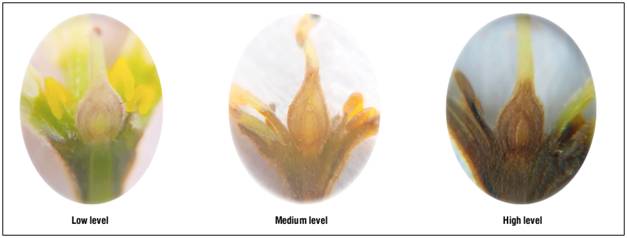INTRODUCTION
In the avocado tree, the events that make up the processes of reproductive biology-such as induction, flowering, pollination, fertilization, and post-fertilization-are extremely complex (Davenport, 1986). Among the unique aspects of the tree's reproductive phase are the high proportion of flowers produced and its low percentage of fruit set, synchronized dichogamy, various pollination routes, the significant drop of fruits over time, and alternate bearing (Lahav and Zamet, 1999; Ish-am, 2005; Wolstenholme, 2010; Thorp et al., 2011; Antione et al., 2013). To manage the crop effectively during this complex developmental phase, it is important to consider that avocado trees produce a large number of flowers, but less than 1% of them eventually become fruit. This occurs due to a massive drop of flowers and developing fruits, primarily within the two months following the end of flowering (Alcaraz and Hormaza Urroz, 2019).
Regarding fruit retention, avocado trees set more fruits than they can bring to maturity. Consequently, during the early developmental stages, the plant undergoes a physiological adjustment in the number of fruits, which triggers a drop in those that cannot set (Bonghi et al., 2000; Costa et al., 2005; D'asaro, 2017). This mechanism for fruit drop aligns with the phenomenon of alternate bearing. Alternatively, another hypothesis centers on carbohydrates, specifically starch. Various studies indicate that higher carbohydrate reserves accumulated in the flower at anthesis are related to greater retention of developing fruits (Alcaraz et al., 2013; Boldingh et al., 2016; Mesejo et al., 2019).
Acknowledging the complexity of avocado pollination and fruiting processes, and the need for precise management to enhance fruit set and retention until harvest, the aim of this study was to determine the effect of starch concentrations in the trunk, roots, flower ovary and young shoots on both the initial and final retention of 'Hass' avocado fruit in two contrasting zones of the Andean tropics of Caldas, Colombia.
MATERIALS AND METHODS
The study was carried out in two commercial orchards located in different altitudinal zones: Villamaría at 2,400 m a.s.l. (5º01'05 N), classified as having a humid, cold climate, and Aranzazu at 1,900 m a.s.l. (5º18'40 N), characterized by a semi-humid, temperate climate. Both orchards are situated in the department of Caldas, Colombia. We marked fifteen 5-year-old ‘Hass’ avocado trees per orchard; additionally, inflorescences, flowers, and fruits were marked in the east and west quadrants of each tree. The soil in both orchards possesses a loamy texture (Soil Survey Staff, 1999), and agricultural management complied with the guidelines set by the ICA (Colombian Agricultural Institute), as specified in Resolutions 448 and 30021 for export-oriented properties. The study spanned from January 2021 to February 2022.
Regarding the fifteen trees selected, they exhibited homogeneity in growth and production values. Their distribution within the orchard was random, bearing in mind that the topography of the land was flat in both areas. On each tree, twenty inflorescences were marked, ten per quadrant (east and west). For each inflorescence, all the flowers were counted, and the fruits retained over time and up to the time of harvest were also counted. Inflorescences were identified with plastic strips, and fruits were tagged with clamps 60 d post-anthesis.
For starch concentration analysis, three samples were taken from young roots, trunk wood, and tender shoots in each orchard. These samples were sealed in properly labeled Ziploc bags and sent to a laboratory for starch quantification via the polarimetry technique (Miernik and Jakubowski, 2021). To determine starch levels in the flower ovaries, we employed the indirect method of Lugol staining. Thirty flower ovaries per orchard were randomly excised, cut longitudinally, stained with Lugol’s solution (Chopy et al., 2023), and then examined under a microscope for staining (Fig 1).
An Apogee Instruments MQ-303 3-sensor quantum sensor was employed to record photosynthetically active radiation (PAR). Data were recorded in each quadrant of four trees per study zone during 6 d at hourly intervals, commencing at 08:00 and concluding at 16:00. To capture data on luminosity, automatic stations were set up on each zone, and data were collected every 5 min, which were expressed in lumens.
A completely randomized design (CRD) served as the methodological framework, treating the individual tree as the experimental unit. We utilized fifteen replicates corresponding to individual trees for variables associated with fruit retention. For the analysis of starch concentrations in roots, trunk, and shoots, tree replicates per tissue per orchard were used. In terms of starch concentration in flower ovaries, fifty replicates per orchard were assessed. The data were subjected to analysis of variance and Tukey's mean comparison test (P≤0.05). The statistical software employed for this analysis was SAS v 9.4 (SAS Inst, Cary, NC).
RESULTS AND DISCUSSION
Photosynthetically active radiation and luminosity
The highest average PAR value was observed in the Aranzazu area, measuring at 1,000 µmol m-2 s-1 (Fig. 2).Conversely, in Villamaría, the peak value surpassed 900 µmol m-2 s-1. Broadly speaking, the graph demonstrates that PAR incidence was higher in Aranzazu. Notable variations were detected specifically at 10:00 and 13:00. Moreover, a decline in PAR values becomes apparent after 14:00 in both zones, suggesting frequent cloud cover across the two orchards.
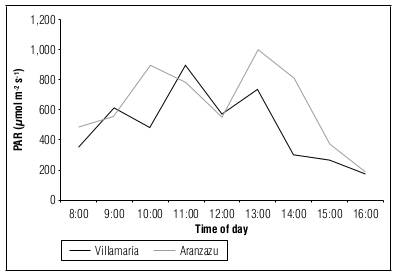
Figure 2. Incidence of photosynthetically active radiation at different times of the day in two contrasting zones of the Andean tropics of Caldas, Colombia.
The incidence of solar radiation in a tree's canopy is directly correlated with the production of photoassimilates (Bastías and Corelli-Grappadelli, 2012; Cherbiy-Hoffmann et al., 2013; Farhat et al., 2016). Similarly, fluctuations in the photosynthetic machinery, induced by variations in light behavior, can either promote an increase in starch synthesis or lead to its degradation into sucrose (Hilliard and West, 1970; Pokhilko et al., 2014). This aspect is noteworthy, as starch concentrations in different parts of the tree can fluctuate based on light availability. As depicted in figure 2, light behavior varies considerably in both zones.
Figure 3 reinforces the observations made regarding PAR in figure 2, indicating significant variability in light availability across both regions. The average luminosity values, recorded over ten consecutive days in both zones, exhibit temporal variations with values ranging from 192,000 to 14,000 lm m-2. The luminosity of a specific area is primarily influenced by its geographic location. In this instance, the proximity to the equator results in photoperiods with minimal fluctuations (Renner, 2007; Yeang, 2007). In other words, the photoperiod in Colombia averages around 12 h, and its variations throughout the year are minimal. Consequently, the times at which the sun rises and sets, as well as the Earth's inclinations at different times of the year, contribute directly to the sun generally setting in the South-West quadrant of the plantations.
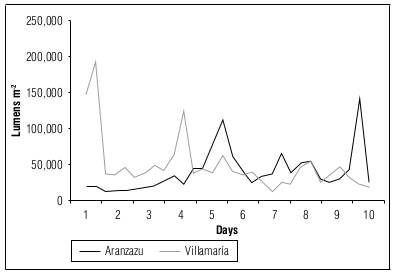
Figure 3. Behavior of luminosity over time in two contrasting zones of the Andean tropics of Caldas, Colombia.
The peaks depicted in figure 3 correspond to the high levels of cloudiness found in the study areas. This cloudiness is influenced by the orography of these mountainous regions in the Colombian Andean tropics and current climate variations, which are characterized by more frequent and prolonged periods of rain throughout most of the year.
These conditions are associated with the La Niña phenomenon (Martínez et al., 2011). Such frequent cloud cover constrains the capture of light by the trees at various times of the day, particularly in the afternoons. Consequently, alterations in light uptake can result in changes in the synthesis and distribution of the starch required by the tree either for reserves or for the formation of simple carbohydrates. Previous studies have demonstrated that prolonged periods of darkness, short photoperiods, low temperatures, and variations in incident radiation during the day can either boost the rate of reserve starch synthesis or increase sucrose synthesis under more stable lighting and PAR conditions (Scholefield et al., 1985; Liu et al., 1999; Graf et al., 2010).
Starch concentrations
In perennial species like the avocado, some of the synthesized starch accumulates in various tissues as a reserve carbohydrate. However, a portion of the starch produced by the plant is immediately utilized by other organs functioning as sinks (Newell et al., 2002; Gott et al., 2006; Palacio et al., 2018). Numerous studies suggest that starch typically accumulating in trunks, roots, and thick branches serves as reserve starch. In contrast, roots, and young shoots, which function as sinks, utilize the starch to convert it into carbohydrates for immediate use (Van Vuuren et al., 1997; Schaffer et al., 2013; Plavcová et al., 2016).
Table 1 reveals that there were no statistically significant differences in starch concentrations across the different tree tissues in both zones. However, there is a trend among the trees in Aranzazu to not accumulate high levels of reserve starch in certain tissues. For example, in the trunk, the highest starch value was observed in Villamaría at 4.30 mg g-1, while in Aranzazu it was 2.30 mg g-1. Regarding roots and young shoots, which are growing tissues, starch levels are subject to frequent change due to ongoing energy expenditure for growth. It is also plausible that a lower level of starch in the young shoots of Aranzazu may be linked to carbohydrate transport to the more numerous flowers on those trees (30,123 flowers), compared to the flower count in Villamaría (12,414 flowers).
Table 1. Starch concentrations in milligrams of starch per gram of dry matter (mg g-1) in different parts of the Hass avocado tree in two zones of the Andean tropics of Caldas, Colombia.
| Location | Roots | Trunk | Young shoots | CV (%) |
|---|---|---|---|---|
| Aranzazu | 1.80 a | 2.30 a | 2.63 a | 18.62 |
| Villamaría | 1.56 a | 4.30 a | 4.30 a | 46.71 |
| CV (%) | 20.29 | 32.06 | 24.92 |
Means followed by the same letters are not significantly different according to Tukey's test (P<0.05).
Regarding starch levels in flower ovaries, significant differences were observed across different levels (Fig. 4A). These differences in starch levels are likely associated with higher fruit retention.
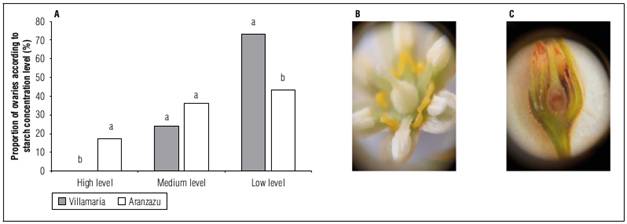
Figure 4. A. Starch levels in the ovaries of 'Hass' avocado flowers in two contrasting zones of the Andean tropics of Caldas, Colombia. B. 'Hass' avocado flower opening in female stage, ovary exposed. C. Longitudinal section of the ovary and stained with lugol. The staining indicates a medium level of starch. Values followed by the same letters are not significantly different according to Tukey's test (P<0.05).
Figure 4A demonstrates that high levels of starch in the ovaries were present solely in the Aranzazu area. In contrast, a higher proportion of ovaries with low starch levels was noted in Villamaría. This suggests that the likelihood of experiencing greater fruit retention is higher in the Aranzazu area, as elevated starch levels in flowers have been correlated with increased rates of fruit set (Finazzo et al., 1994; Thorp et al., 2011; Alcaraz et al., 2013; Boldingh et al., 2016).
Fruit retention
Figure 5 depicts a favorable trend in the Aranzazu zone regarding fruit retention over time. While both zones exhibit a significant drop in the initial stages, the Aranzazu area outperformed in each evaluation period, exhibiting significant differences.
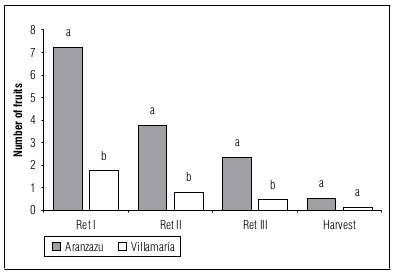
Figure 5. 'Hass' avocado fruit retention over time in two contrasting zones in the Andean tropics of Caldas, Colombia. Ret I: fruit retention 60 days after anthesis. Ret II: fruit retention 90 days after anthesis. Ret III: fruit retention 120 days after anthesis. Harvest: fruit retention at harvest. Values followed by the same letters are not significantly different according to Tukey's test (P<0.05).
While previous studies have reported that early fruit drop is common in the 'Hass' avocado (Boldingh et al., 2016; Garner and Lovatt, 2016; Silva et al., 2017), consistent with our observations in both study zones, it is notable that a substantial difference emerges starting 60 days after anthesis. Specifically, the Aranzazu zone reports an average of 7.2 fruits, as opposed to 1.8 in Villamaría. This trend persists until harvest, where, despite the low numbers, Aranzazu continues to display higher fruit retention. These results suggest a correlation between starch concentrations in flower ovaries and fruit retention, particularly since it was the Aranzazu zone that exhibited high starch levels.
Upon analyzing fruit retention in the east and west quadrants across the two zones, differences were evident not only between quadrants but also between localities. In the Aranzazu zone, the final retention was higher in the east quadrant, registering at 0.80, whereas in the Villamaría zone, the final fruit retention was higher in the west quadrant, coming in at 0.33 (Tab. 2).
Table 2. 'Hass' avocado fruit retention in the east and west quadrants in two contrasting zones of the Andean tropics of Caldas, Colombia.
| Location | Quadrant | RetI | RetII | RetIII | Harv | ||||
|---|---|---|---|---|---|---|---|---|---|
| Mean | SD | Mean | SD | Mean | SD | Mean | SD | ||
| Aranzazu | E | 7.07 | 9.06 | 3.27 | 3.97 | 2.40 | 2.41 | 0.80 | 1.01 |
| Aranzazu | W | 7.47 | 12.17 | 4.40 | 7.93 | 2.47 | 5.04 | 0.53 | 0.74 |
| Villamaría | E | 2.53 | 2.83 | 1.07 | 2.34 | 0.47 | 1.36 | 0.13 | 0.52 |
| Villamaría | W | 1.07 | 1.16 | 0.67 | 1.11 | 0.53 | 1.13 | 0.33 | 1.05 |
*E: East W: West. RetI: fruit retention 60 days after anthesis. RetII: fruit retention 90 days after anthesis.RetIII: fruit retention 120 days after anthesis. Harv: fruit retention at harvest. SD: Standard deviation.
This reproductive behavior is likely directly related to PAR incidence levels in trees in both zones (Abraha and Savage, 2010; Menzel and Le Lagadec, 2014; Wilkie et al., 2019). Given that average radiation levels were higher in the Aranzazu zone, it can be inferred that photosynthetic activity may have been more robust there, potentially leading to increased starch synthesis and, consequently, greater fruit retention.
Fruit retention in perennial species like avocado is intricately tied to the production of photoassimilates, as well as their distribution and accumulation in various parts of the tree. Elevated starch concentrations in flowers have been linked to increased fruit retention. The findings of this study reveal significant differences in the incidence of PAR between the two regions examined. Concurrently, disparities are observed between starch concentrations and final fruit retention at harvest.
CONCLUSION
Observations indicate significant differences in both fruit retention and starch levels in the flower ovaries between the two evaluated zones. The behavior of PAR and luminosity also differed, noting higher average PAR values in Aranzazu and high luminosity variability in both locations. This variability suggests the frequent presence of clouds, which could, in turn, affect the trees' photosynthetic machinery. Though concentrations of starch in roots, trunks, and shoots did not exhibit statistical differences between the two zones, it was observed that starch levels in trunks -a reserve- were lower in Aranzazu. This might suggest a greater utilization of immediate carbohydrates to meet the demands of flowering and fruiting, attributable to the source-sink dynamics.
In conclusion, our findings confirm a direct relationship between starch levels and both initial and final fruit retention. Aranzazu, in particular, demonstrated higher proportions of flowers with medium and high levels of starch, and it was precisely in this zone where higher initial and harvest values of retained fruit were recorded.
This study illuminates the existing differences at the production level between zones with varying environments. It also substantiates the close relationship between starch content in flowers and various tree tissues, and the retention of fruit over time. For future research, it is recommended to delve into understanding the role of carbohydrates, specifically starch, in the quality of flowers, fruit set, and both initial and final fruit retention in Hass avocado trees.














